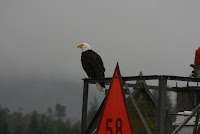We were up early and weighed anchor at 0645, not too much mud to wash off today. What a day, sunny and totally calm. Tracy Arm is a glacial fjord some 25 miles long with two forks at the end each of which has a glacier, the Sawyer. We headed up the channel and into the icebergs, sighting a humpback whale inside the arm; interesting.
 |
| Titanic moment |
There was a lot of ice in the arm and pretty soon the radar screen had an
attack of the measles; we had to hand steer all the way up the channel.
 |
| Icebergs on the radar |
We were travelling very slowly and every corner we went round the ice was thicker and thicker. I was thinking about giving up but then it seemed to become easier to steer. There was the odd bump from a small piece of ice and I kept wondering what Harris at our haul out yard in Seattle would say if I left any red paint on any of the bergs.
 |
| Gin and tonic country |
Actually much of the ice was in very small pieces and the house sized bergs were not difficult to avoid. The worst ones were the translucent chunks, probably the most dense ice from the bottom of the glacier. They sported some nasty looking sharp points so we were careful when they showed up. Finally we made it to Sawyer Island at the junction of the two forks, it was time to float around and look at the amazing spectacle of the glacier.
 |
| South Sawyer Glacier |
Driving Last Mango through the ice flow was as difficult as positioning these photos on the blog
 |
| Admiral at the glacier |
posts!
The journey back was a bit easier,
our faint wake had left somewhat of a cleared path. After exiting the small
area of water at the fork, and on our way back up the arm, we were
surprised to see first a 25 knot cat
sightseeing cruiser, then the cruise ship Carnival Spirit, then the cruise ship Disney Wonder all disappear
 |
| Cruise ship Carnaval Spirit |
behind us into the channel. We were thankful to have had our own secluded time at the glacier and also thankful that Last Mango didn't have to dodge around between those big guys jostling around in there, don't know how they managed to manouvre around.
 |
| Lonely little guy |
While we are travelling we are always scanning the beaches, particularly at low tide, just in case we see something..........yes, there was this lonely little guy checking over a beach for something to eat, a black bear. Finally we have seen our first bear, no doubt there will be plenty more over the coming couple of months that we are going to be cruising in the PNW.
We headed back into our anchorage at Tracy Arm Cove and were surprised to see that we were not alone..................
A grizzly sow and three cubs were feeding on the shore. All the noise from dropping the anchor didn't faze them one bit, they just carried on browsing away all round the bay. Our own private grizzly show went on until dusk.
Secure in our anchorage we monitored the radio and heard the cruise
ships making their "securite" announcements at the Big Bend turn and crossing the bar. From our viewpoint we could see these ships with thousands of folk on board passing by.........mama grizzly and cubs carried on rooting around, having the occasional doze, and finally drifting off into the forest.
What a day.

















































